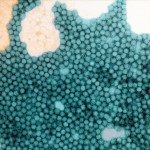Lien vers Pubmed [PMID] – 2416957
J. Virol. 1986 Jan;57(1):81-90
Antigenic variants resistant to eight neutralizing monoclonal antibodies were selected from wild (Mahoney) and attenuated (Sabin) type 1 infectious poliovirions. Cross-immunoprecipitation revealed interrelationships between epitopes which were not detected by cross-neutralization. Operational analysis of antigenic variants showed that seven of eight neutralization epitopes studied were interrelated. Only one neutralization epitope, named Kc, varied independently from all the others. This latter, recognized by C3 neutralizing monoclonal antibody, was present not only on infectious virions but also on heat-denatured (C-antigenic) particles and on isolated capsid protein VP1. Loss of the neutralization function of an epitope did not necessary result from the loss of its antibody-binding capacity. Such potential, but not functional, neutralization epitopes exist naturally on Mahoney and Sabin 1 viruses. Their antibody-binding property could be disrupted by isolating antigenic variants in the presence of the nonneutralizing monoclonal antibody and anti-mouse immunoglobulin antibodies. Single-point mutations responsible for the acquisition of resistance to neutralization in the antigenic variants were located by sequence analyses of their genomes. Mutants selected in the presence of C3 neutralizing monoclonal antibody always had the mutation located inside the antibody-binding site (residues 93 through 103 of VP1) at the amino acid position 100 of VP1. On the contrary, antigenic variants selected in the presence of neutralizing monoclonal antibodies reacting only with D-antigenic particles had mutations situated in VP3, outside the antibody-binding site (residues 93 through 103 of VP1). The complete conversion of the Mahoney to the Sabin 1 epitope map resulted from a threonine-to-lysine substitution at position 60 of VP3.

